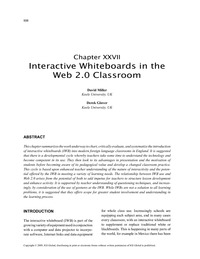Interactive Whiteboards in the Web 2.0 ClassroomDavid Miller, Derek Glover
Zu finden in: Handbook of Research on Web 2.0 and Second Language Learning (Seite 506 bis 525), 2008
  |
 |
 Diese Seite wurde seit 2 Jahren inhaltlich nicht mehr aktualisiert.
Unter Umständen ist sie nicht mehr aktuell.
Diese Seite wurde seit 2 Jahren inhaltlich nicht mehr aktualisiert.
Unter Umständen ist sie nicht mehr aktuell.
 Zusammenfassungen
Zusammenfassungen
 This chapter concentrates on the outcomes
of research that has been centered on the way in
which IWB users, both teachers and learners,
have developed their use of hardware and software
to enhance teaching and learning in modern
foreign language teaching.
This chapter concentrates on the outcomes
of research that has been centered on the way in
which IWB users, both teachers and learners,
have developed their use of hardware and software
to enhance teaching and learning in modern
foreign language teaching. This chapter summarizes the work underway to chart, critically evaluate, and systematize the introduction of interactive whiteboards (IWB) into modern foreign language classrooms in England. It is suggested that there is a developmental cycle whereby teachers take some time to understand the technology and become competent in its use. They then look to its advantages in presentation and the motivation of students before becoming aware of its pedagogical value and develop a changed classroom practice. This cycle is based upon enhanced teacher understanding of the nature of interactivity and the potential offered by the IWB in meeting a variety of learning needs. The relationship between IWB use and Web 2.0 arises from the potential of both to add impetus for teachers to structure lesson development and enhance activity. It is supported by teacher understanding of questioning techniques, and increasingly, by consideration of the use of gestures at the IWB. While IWBs are not a solution to all learning problems, it is suggested that they offers scope for greater student involvement and understanding in the learning process.
This chapter summarizes the work underway to chart, critically evaluate, and systematize the introduction of interactive whiteboards (IWB) into modern foreign language classrooms in England. It is suggested that there is a developmental cycle whereby teachers take some time to understand the technology and become competent in its use. They then look to its advantages in presentation and the motivation of students before becoming aware of its pedagogical value and develop a changed classroom practice. This cycle is based upon enhanced teacher understanding of the nature of interactivity and the potential offered by the IWB in meeting a variety of learning needs. The relationship between IWB use and Web 2.0 arises from the potential of both to add impetus for teachers to structure lesson development and enhance activity. It is supported by teacher understanding of questioning techniques, and increasingly, by consideration of the use of gestures at the IWB. While IWBs are not a solution to all learning problems, it is suggested that they offers scope for greater student involvement and understanding in the learning process.
 Dieser Text erwähnt ...
Dieser Text erwähnt ...
 Personen KB IB clear | Steve Higgins , Jen Miller , Heather J. Smith , Lew Semjonowitsch Vygotsky , Kate Wall | ||||||||||||||||||
 Begriffe KB IB clear |  Interaktive Whiteboards Interaktive Whiteboards interactive whiteboard
, interactive whiteboard
,  konstruktivistische Überzeugung
, konstruktivistische Überzeugung
,  Lernen Lernen learning
, learning
,  Sprache Sprache language
, Sprachenlernenlanguage learning
, language
, Sprachenlernenlanguage learning
,  transmissive Überzeugung transmissive Überzeugung
| ||||||||||||||||||
 Bücher |
| ||||||||||||||||||
 Texte |
|
 Dieser Text erwähnt vermutlich nicht ...
Dieser Text erwähnt vermutlich nicht ... 
 Nicht erwähnte Begriffe | Fremdsprache, Fremdsprachenlernen |
 Tagcloud
Tagcloud
 Zitationsgraph
Zitationsgraph
 Zitationsgraph (Beta-Test mit vis.js)
Zitationsgraph (Beta-Test mit vis.js)
 Anderswo finden
Anderswo finden
 Volltext dieses Dokuments
Volltext dieses Dokuments
 Anderswo suchen
Anderswo suchen 
 Beat und dieser Text
Beat und dieser Text
Beat hat Dieser Text während seiner Zeit am Institut für Medien und Schule (IMS) ins Biblionetz aufgenommen. Beat besitzt kein physisches, aber ein digitales Exemplar. Eine digitale Version ist auf dem Internet verfügbar (s.o.). Aufgrund der wenigen Einträge im Biblionetz scheint er es nicht wirklich gelesen zu haben. Es gibt bisher auch nur wenige Objekte im Biblionetz, die dieses Werk zitieren.










 , 585 kByte;
, 585 kByte;  Link unterbrochen? Letzte Überprüfung: 2021-03-21 Letzte erfolgreiche Überprüfung: 2015-02-28)
Link unterbrochen? Letzte Überprüfung: 2021-03-21 Letzte erfolgreiche Überprüfung: 2015-02-28)  Biblionetz-History
Biblionetz-History